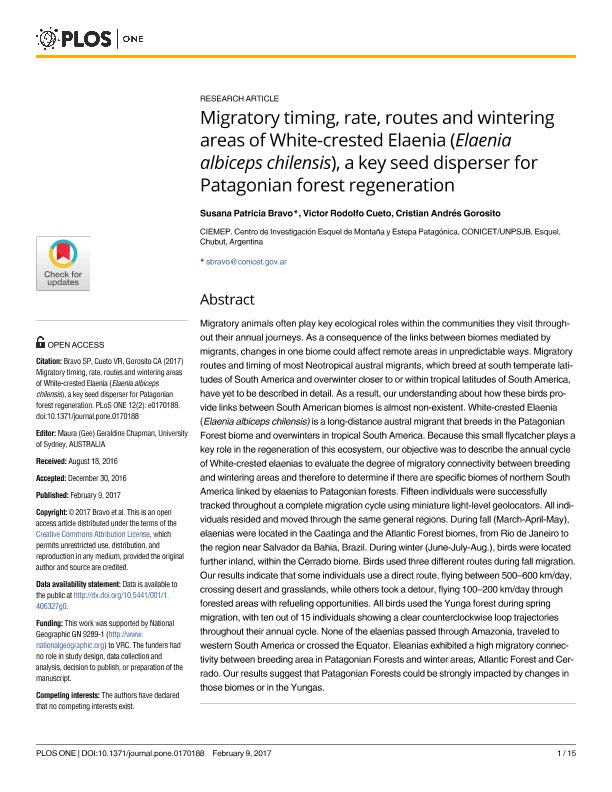Artículo
Migratory timing, rate, routes and wintering areas of White-crested Elaenia (Elaenia albiceps chilensis), a key seed disperser for Patagonian Forest regeneration
Fecha de publicación:
02/2017
Editorial:
Public Library of Science
Revista:
Plos One
ISSN:
1932-6203
Idioma:
Inglés
Tipo de recurso:
Artículo publicado
Clasificación temática:
Resumen
Migratory animals often play key ecological roles within the communities they visit throughout their annual journeys. As a consequence of the links between biomes mediated by migrants, changes in one biome could affect remote areas in unpredictable ways. Migratory routes and timing of most Neotropical austral migrants, which breed at south temperate latitudes of South America and overwinter closer to or within tropical latitudes of South America, have yet to be described in detail. As a result, our understanding about how these birds provide links between South American biomes is almost non-existent. White-crested Elaenia (Elaenia albiceps chilensis) is a long-distance austral migrant that breeds in the Patagonian Forest biome and overwinters in tropical South America. Because this small flycatcher plays a key role in the regeneration of this ecosystem, our objective was to describe the annual cycle of White-crested elaenias to evaluate the degree of migratory connectivity between breeding and wintering areas and therefore to determine if there are specific biomes of northern South America linked by elaenias to Patagonian forests. Fifteen individuals were successfully tracked throughout a complete migration cycle using miniature light-level geolocators. All individuals resided and moved through the same general regions. During fall (March-April-May), elaenias were located in the Caatinga and the Atlantic Forest biomes, from Rio de Janeiro to the region near Salvador da Bahia, Brazil. During winter (June-July-Aug.), birds were located further inland, within the Cerrado biome. Birds used three different routes during fall migration. Our results indicate that some individuals use a direct route, flying between 500-600 km/day, crossing desert and grasslands, while others took a detour, flying 100-200 km/day through forested areas with refueling opportunities. All birds used the Yunga forest during spring migration, with ten out of 15 individuals showing a clear counterclockwise loop trajectories throughout their annual cycle. None of the elaenias passed through Amazonia, traveled to western South America or crossed the Equator. Eleanias exhibited a high migratory connectivity between breeding area in Patagonian Forests and winter areas, Atlantic Forest and Cerrado. Our results suggest that Patagonian Forests could be strongly impacted by changes in those biomes or in the Yungas.
Palabras clave:
Bird Migration
,
South America
,
Small Light-Level Geolocators
,
Loop Migration
Archivos asociados
Licencia
Identificadores
Colecciones
Articulos(CIEMEP)
Articulos de CENTRO DE INVESTIGACION ESQUEL DE MONTAÑA Y ESTEPA PATAGONICA
Articulos de CENTRO DE INVESTIGACION ESQUEL DE MONTAÑA Y ESTEPA PATAGONICA
Citación
Bravo, Susana Patricia; Cueto, Víctor; Gorosito, Cristian Andrés; Migratory timing, rate, routes and wintering areas of White-crested Elaenia (Elaenia albiceps chilensis), a key seed disperser for Patagonian Forest regeneration; Public Library of Science; Plos One; 12; 2; 2-2017
Compartir
Altmétricas




